Business Strategy Report: Analyzing Unilever's Competitive Landscape
VerifiedAdded on 2020/12/18
|15
|5250
|106
Report
AI Summary
This report provides a comprehensive analysis of Unilever's business strategy. It begins with an introduction to business strategy and its importance in achieving organizational objectives. The report then delves into the macro environment analysis using PESTLE and SWOT frameworks, examining political, economic, social, technological, legal, and environmental factors impacting Unilever. It also assesses Unilever's internal capabilities and competitive advantages through VRIO analysis. Furthermore, the report applies Porter's Five Forces model to understand the competitive landscape and concludes with strategic recommendations for Unilever. The report covers the company's operations in over 190 countries and its position in the FMCG industry.
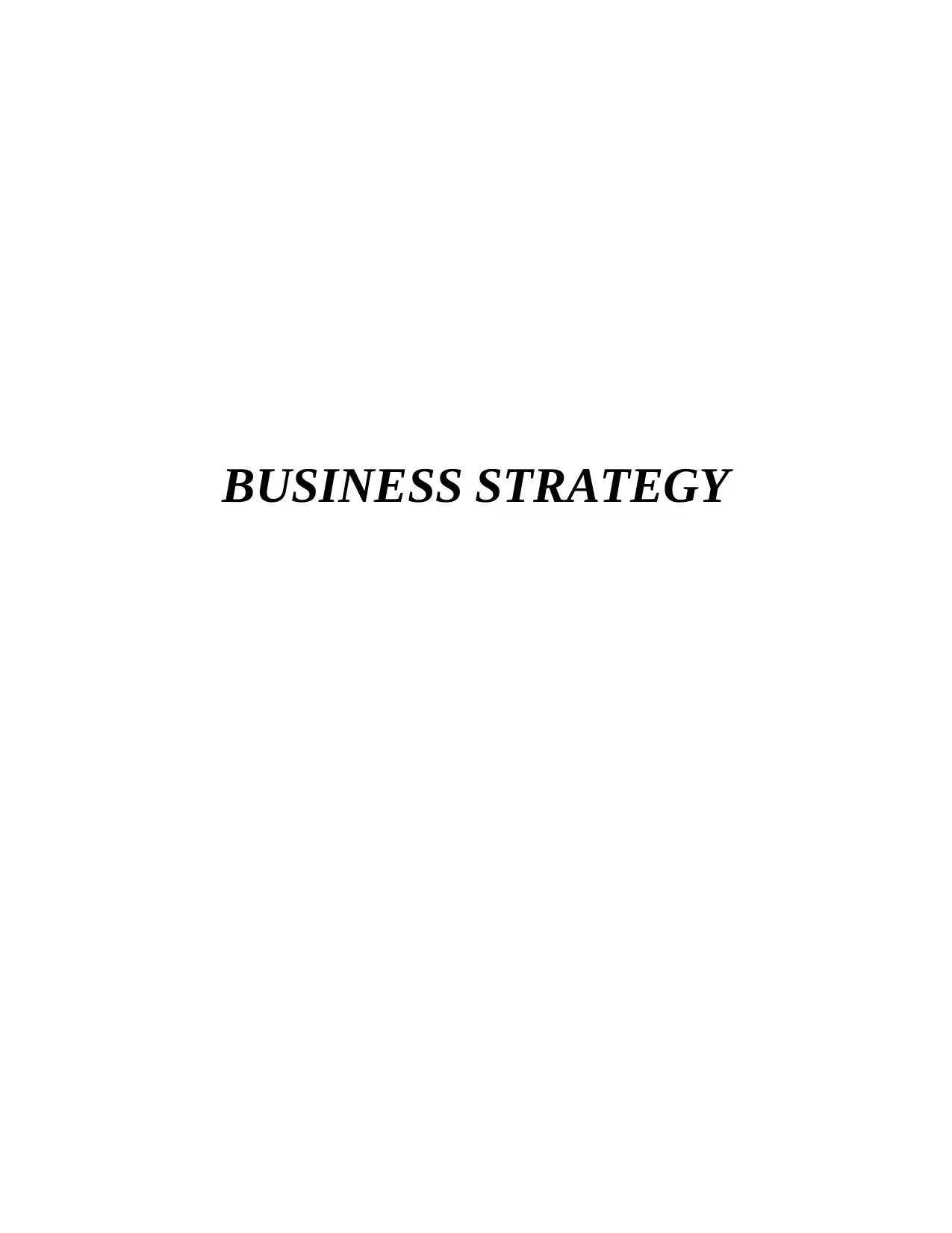
BUSINESS STRATEGY
Paraphrase This Document
Need a fresh take? Get an instant paraphrase of this document with our AI Paraphraser
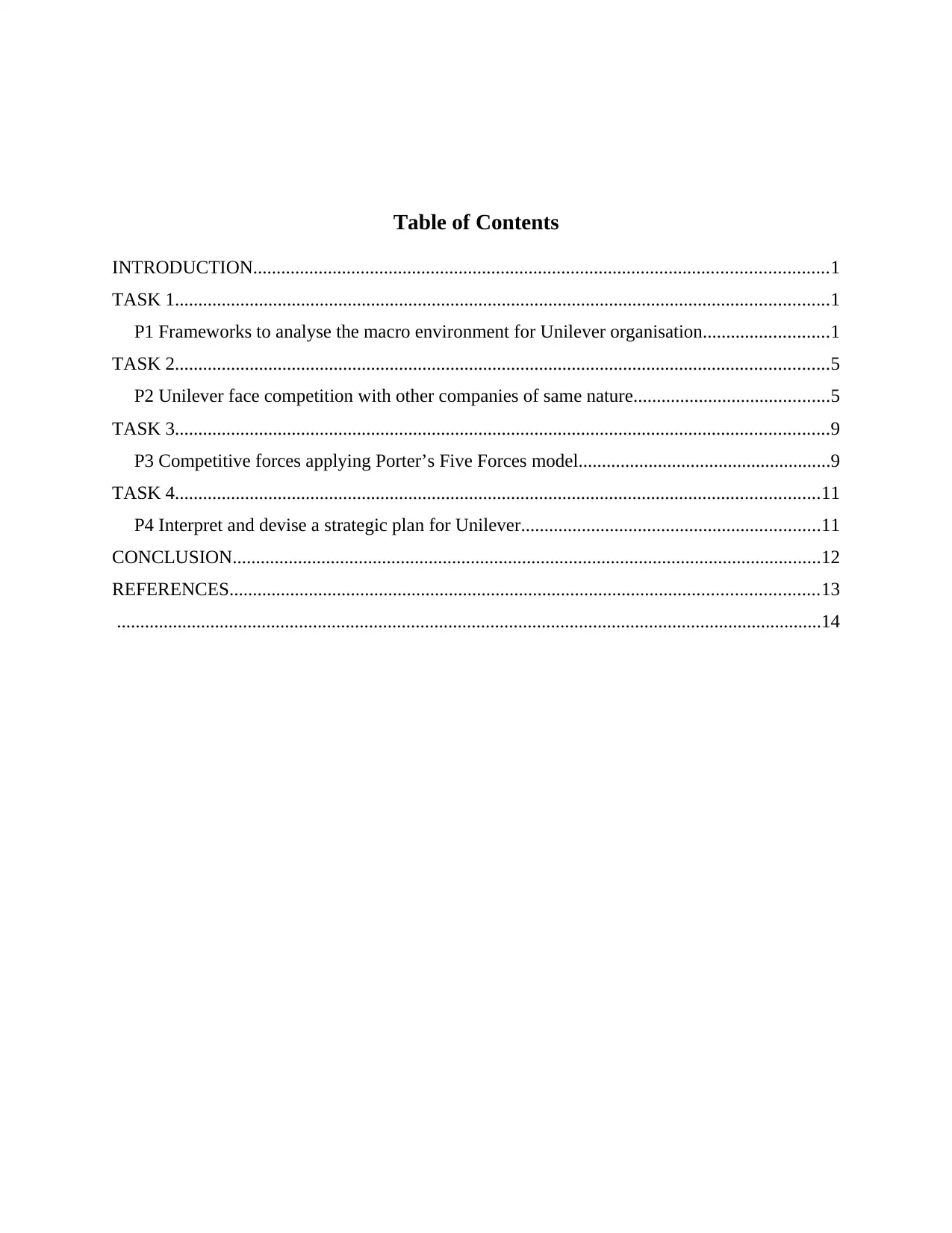
Table of Contents
INTRODUCTION...........................................................................................................................1
TASK 1............................................................................................................................................1
P1 Frameworks to analyse the macro environment for Unilever organisation...........................1
TASK 2............................................................................................................................................5
P2 Unilever face competition with other companies of same nature..........................................5
TASK 3............................................................................................................................................9
P3 Competitive forces applying Porter’s Five Forces model......................................................9
TASK 4..........................................................................................................................................11
P4 Interpret and devise a strategic plan for Unilever................................................................11
CONCLUSION..............................................................................................................................12
REFERENCES..............................................................................................................................13
.......................................................................................................................................................14
INTRODUCTION...........................................................................................................................1
TASK 1............................................................................................................................................1
P1 Frameworks to analyse the macro environment for Unilever organisation...........................1
TASK 2............................................................................................................................................5
P2 Unilever face competition with other companies of same nature..........................................5
TASK 3............................................................................................................................................9
P3 Competitive forces applying Porter’s Five Forces model......................................................9
TASK 4..........................................................................................................................................11
P4 Interpret and devise a strategic plan for Unilever................................................................11
CONCLUSION..............................................................................................................................12
REFERENCES..............................................................................................................................13
.......................................................................................................................................................14
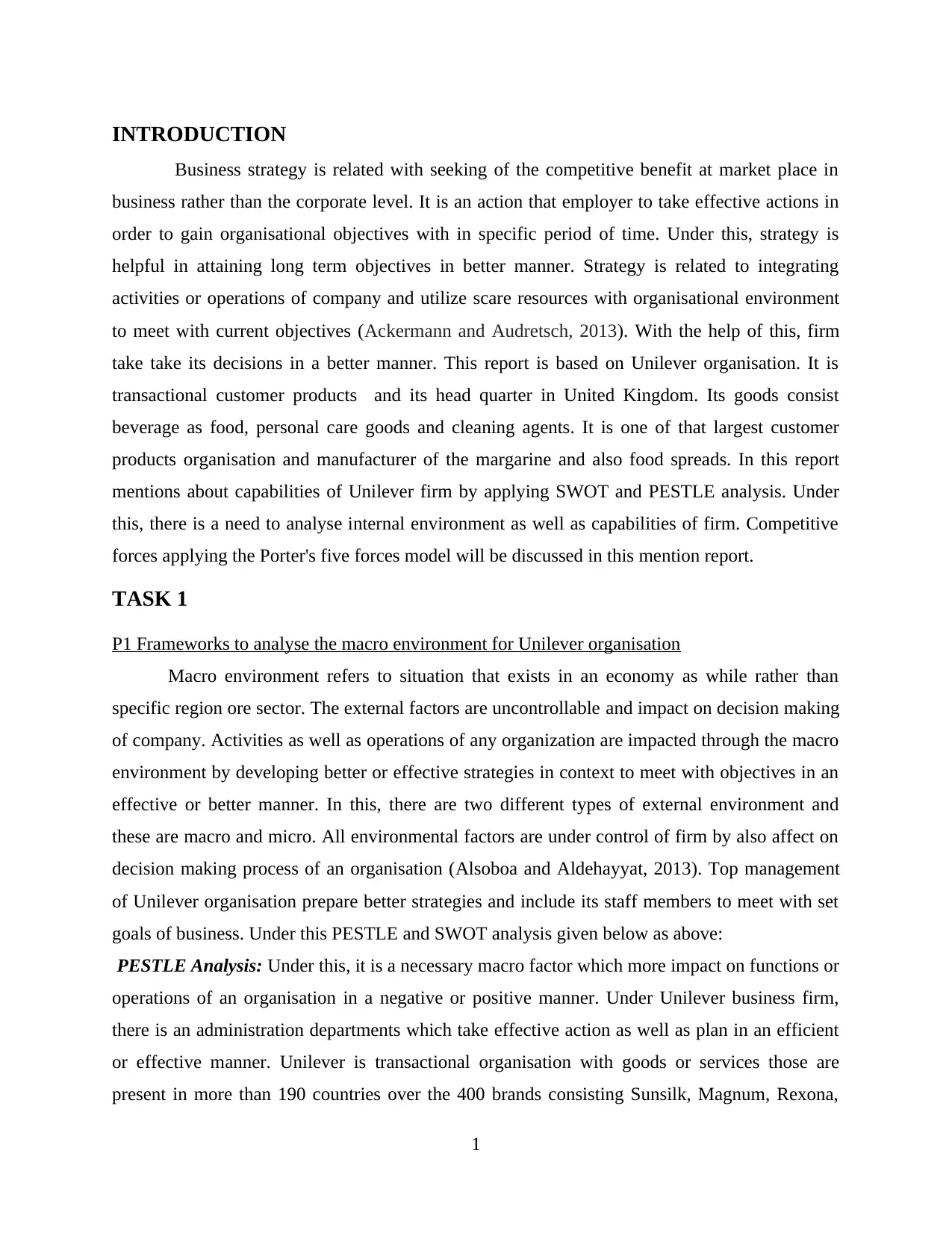
INTRODUCTION
Business strategy is related with seeking of the competitive benefit at market place in
business rather than the corporate level. It is an action that employer to take effective actions in
order to gain organisational objectives with in specific period of time. Under this, strategy is
helpful in attaining long term objectives in better manner. Strategy is related to integrating
activities or operations of company and utilize scare resources with organisational environment
to meet with current objectives (Ackermann and Audretsch, 2013). With the help of this, firm
take take its decisions in a better manner. This report is based on Unilever organisation. It is
transactional customer products and its head quarter in United Kingdom. Its goods consist
beverage as food, personal care goods and cleaning agents. It is one of that largest customer
products organisation and manufacturer of the margarine and also food spreads. In this report
mentions about capabilities of Unilever firm by applying SWOT and PESTLE analysis. Under
this, there is a need to analyse internal environment as well as capabilities of firm. Competitive
forces applying the Porter's five forces model will be discussed in this mention report.
TASK 1
P1 Frameworks to analyse the macro environment for Unilever organisation
Macro environment refers to situation that exists in an economy as while rather than
specific region ore sector. The external factors are uncontrollable and impact on decision making
of company. Activities as well as operations of any organization are impacted through the macro
environment by developing better or effective strategies in context to meet with objectives in an
effective or better manner. In this, there are two different types of external environment and
these are macro and micro. All environmental factors are under control of firm by also affect on
decision making process of an organisation (Alsoboa and Aldehayyat, 2013). Top management
of Unilever organisation prepare better strategies and include its staff members to meet with set
goals of business. Under this PESTLE and SWOT analysis given below as above:
PESTLE Analysis: Under this, it is a necessary macro factor which more impact on functions or
operations of an organisation in a negative or positive manner. Under Unilever business firm,
there is an administration departments which take effective action as well as plan in an efficient
or effective manner. Unilever is transactional organisation with goods or services those are
present in more than 190 countries over the 400 brands consisting Sunsilk, Magnum, Rexona,
1
Business strategy is related with seeking of the competitive benefit at market place in
business rather than the corporate level. It is an action that employer to take effective actions in
order to gain organisational objectives with in specific period of time. Under this, strategy is
helpful in attaining long term objectives in better manner. Strategy is related to integrating
activities or operations of company and utilize scare resources with organisational environment
to meet with current objectives (Ackermann and Audretsch, 2013). With the help of this, firm
take take its decisions in a better manner. This report is based on Unilever organisation. It is
transactional customer products and its head quarter in United Kingdom. Its goods consist
beverage as food, personal care goods and cleaning agents. It is one of that largest customer
products organisation and manufacturer of the margarine and also food spreads. In this report
mentions about capabilities of Unilever firm by applying SWOT and PESTLE analysis. Under
this, there is a need to analyse internal environment as well as capabilities of firm. Competitive
forces applying the Porter's five forces model will be discussed in this mention report.
TASK 1
P1 Frameworks to analyse the macro environment for Unilever organisation
Macro environment refers to situation that exists in an economy as while rather than
specific region ore sector. The external factors are uncontrollable and impact on decision making
of company. Activities as well as operations of any organization are impacted through the macro
environment by developing better or effective strategies in context to meet with objectives in an
effective or better manner. In this, there are two different types of external environment and
these are macro and micro. All environmental factors are under control of firm by also affect on
decision making process of an organisation (Alsoboa and Aldehayyat, 2013). Top management
of Unilever organisation prepare better strategies and include its staff members to meet with set
goals of business. Under this PESTLE and SWOT analysis given below as above:
PESTLE Analysis: Under this, it is a necessary macro factor which more impact on functions or
operations of an organisation in a negative or positive manner. Under Unilever business firm,
there is an administration departments which take effective action as well as plan in an efficient
or effective manner. Unilever is transactional organisation with goods or services those are
present in more than 190 countries over the 400 brands consisting Sunsilk, Magnum, Rexona,
1
⊘ This is a preview!⊘
Do you want full access?
Subscribe today to unlock all pages.

Trusted by 1+ million students worldwide
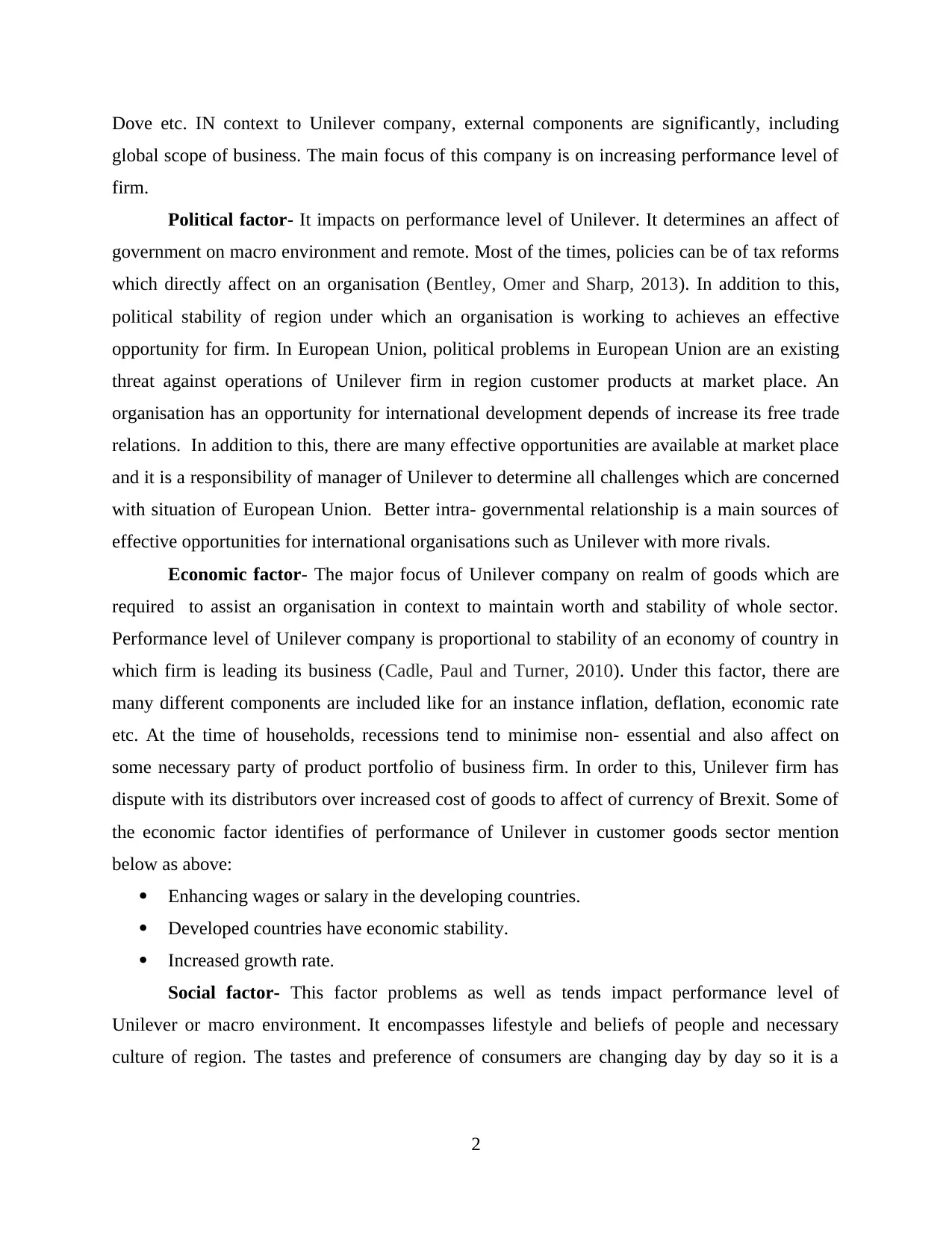
Dove etc. IN context to Unilever company, external components are significantly, including
global scope of business. The main focus of this company is on increasing performance level of
firm.
Political factor- It impacts on performance level of Unilever. It determines an affect of
government on macro environment and remote. Most of the times, policies can be of tax reforms
which directly affect on an organisation (Bentley, Omer and Sharp, 2013). In addition to this,
political stability of region under which an organisation is working to achieves an effective
opportunity for firm. In European Union, political problems in European Union are an existing
threat against operations of Unilever firm in region customer products at market place. An
organisation has an opportunity for international development depends of increase its free trade
relations. In addition to this, there are many effective opportunities are available at market place
and it is a responsibility of manager of Unilever to determine all challenges which are concerned
with situation of European Union. Better intra- governmental relationship is a main sources of
effective opportunities for international organisations such as Unilever with more rivals.
Economic factor- The major focus of Unilever company on realm of goods which are
required to assist an organisation in context to maintain worth and stability of whole sector.
Performance level of Unilever company is proportional to stability of an economy of country in
which firm is leading its business (Cadle, Paul and Turner, 2010). Under this factor, there are
many different components are included like for an instance inflation, deflation, economic rate
etc. At the time of households, recessions tend to minimise non- essential and also affect on
some necessary party of product portfolio of business firm. In order to this, Unilever firm has
dispute with its distributors over increased cost of goods to affect of currency of Brexit. Some of
the economic factor identifies of performance of Unilever in customer goods sector mention
below as above:
Enhancing wages or salary in the developing countries.
Developed countries have economic stability.
Increased growth rate.
Social factor- This factor problems as well as tends impact performance level of
Unilever or macro environment. It encompasses lifestyle and beliefs of people and necessary
culture of region. The tastes and preference of consumers are changing day by day so it is a
2
global scope of business. The main focus of this company is on increasing performance level of
firm.
Political factor- It impacts on performance level of Unilever. It determines an affect of
government on macro environment and remote. Most of the times, policies can be of tax reforms
which directly affect on an organisation (Bentley, Omer and Sharp, 2013). In addition to this,
political stability of region under which an organisation is working to achieves an effective
opportunity for firm. In European Union, political problems in European Union are an existing
threat against operations of Unilever firm in region customer products at market place. An
organisation has an opportunity for international development depends of increase its free trade
relations. In addition to this, there are many effective opportunities are available at market place
and it is a responsibility of manager of Unilever to determine all challenges which are concerned
with situation of European Union. Better intra- governmental relationship is a main sources of
effective opportunities for international organisations such as Unilever with more rivals.
Economic factor- The major focus of Unilever company on realm of goods which are
required to assist an organisation in context to maintain worth and stability of whole sector.
Performance level of Unilever company is proportional to stability of an economy of country in
which firm is leading its business (Cadle, Paul and Turner, 2010). Under this factor, there are
many different components are included like for an instance inflation, deflation, economic rate
etc. At the time of households, recessions tend to minimise non- essential and also affect on
some necessary party of product portfolio of business firm. In order to this, Unilever firm has
dispute with its distributors over increased cost of goods to affect of currency of Brexit. Some of
the economic factor identifies of performance of Unilever in customer goods sector mention
below as above:
Enhancing wages or salary in the developing countries.
Developed countries have economic stability.
Increased growth rate.
Social factor- This factor problems as well as tends impact performance level of
Unilever or macro environment. It encompasses lifestyle and beliefs of people and necessary
culture of region. The tastes and preference of consumers are changing day by day so it is a
2
Paraphrase This Document
Need a fresh take? Get an instant paraphrase of this document with our AI Paraphraser
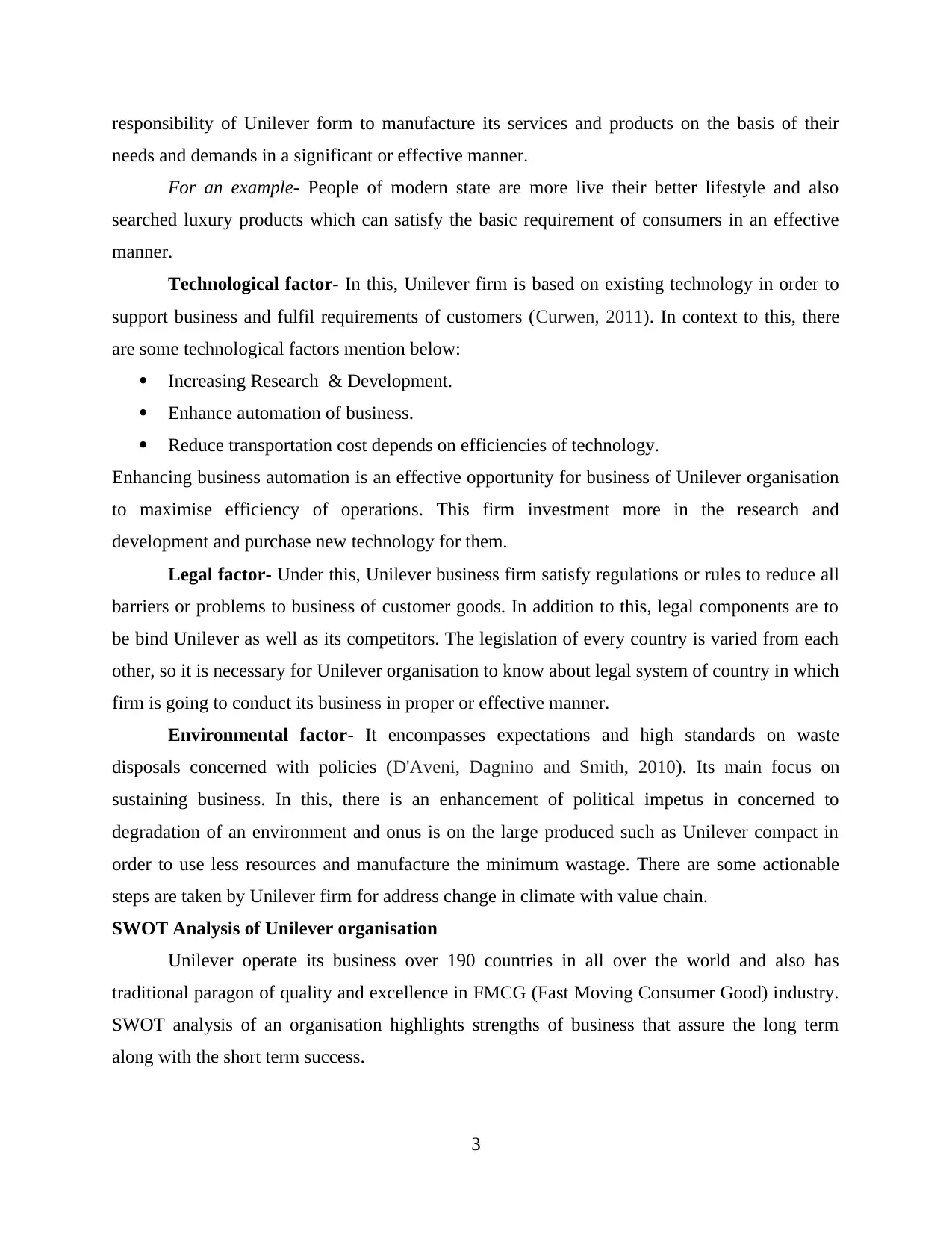
responsibility of Unilever form to manufacture its services and products on the basis of their
needs and demands in a significant or effective manner.
For an example- People of modern state are more live their better lifestyle and also
searched luxury products which can satisfy the basic requirement of consumers in an effective
manner.
Technological factor- In this, Unilever firm is based on existing technology in order to
support business and fulfil requirements of customers (Curwen, 2011). In context to this, there
are some technological factors mention below:
Increasing Research & Development.
Enhance automation of business.
Reduce transportation cost depends on efficiencies of technology.
Enhancing business automation is an effective opportunity for business of Unilever organisation
to maximise efficiency of operations. This firm investment more in the research and
development and purchase new technology for them.
Legal factor- Under this, Unilever business firm satisfy regulations or rules to reduce all
barriers or problems to business of customer goods. In addition to this, legal components are to
be bind Unilever as well as its competitors. The legislation of every country is varied from each
other, so it is necessary for Unilever organisation to know about legal system of country in which
firm is going to conduct its business in proper or effective manner.
Environmental factor- It encompasses expectations and high standards on waste
disposals concerned with policies (D'Aveni, Dagnino and Smith, 2010). Its main focus on
sustaining business. In this, there is an enhancement of political impetus in concerned to
degradation of an environment and onus is on the large produced such as Unilever compact in
order to use less resources and manufacture the minimum wastage. There are some actionable
steps are taken by Unilever firm for address change in climate with value chain.
SWOT Analysis of Unilever organisation
Unilever operate its business over 190 countries in all over the world and also has
traditional paragon of quality and excellence in FMCG (Fast Moving Consumer Good) industry.
SWOT analysis of an organisation highlights strengths of business that assure the long term
along with the short term success.
3
needs and demands in a significant or effective manner.
For an example- People of modern state are more live their better lifestyle and also
searched luxury products which can satisfy the basic requirement of consumers in an effective
manner.
Technological factor- In this, Unilever firm is based on existing technology in order to
support business and fulfil requirements of customers (Curwen, 2011). In context to this, there
are some technological factors mention below:
Increasing Research & Development.
Enhance automation of business.
Reduce transportation cost depends on efficiencies of technology.
Enhancing business automation is an effective opportunity for business of Unilever organisation
to maximise efficiency of operations. This firm investment more in the research and
development and purchase new technology for them.
Legal factor- Under this, Unilever business firm satisfy regulations or rules to reduce all
barriers or problems to business of customer goods. In addition to this, legal components are to
be bind Unilever as well as its competitors. The legislation of every country is varied from each
other, so it is necessary for Unilever organisation to know about legal system of country in which
firm is going to conduct its business in proper or effective manner.
Environmental factor- It encompasses expectations and high standards on waste
disposals concerned with policies (D'Aveni, Dagnino and Smith, 2010). Its main focus on
sustaining business. In this, there is an enhancement of political impetus in concerned to
degradation of an environment and onus is on the large produced such as Unilever compact in
order to use less resources and manufacture the minimum wastage. There are some actionable
steps are taken by Unilever firm for address change in climate with value chain.
SWOT Analysis of Unilever organisation
Unilever operate its business over 190 countries in all over the world and also has
traditional paragon of quality and excellence in FMCG (Fast Moving Consumer Good) industry.
SWOT analysis of an organisation highlights strengths of business that assure the long term
along with the short term success.
3
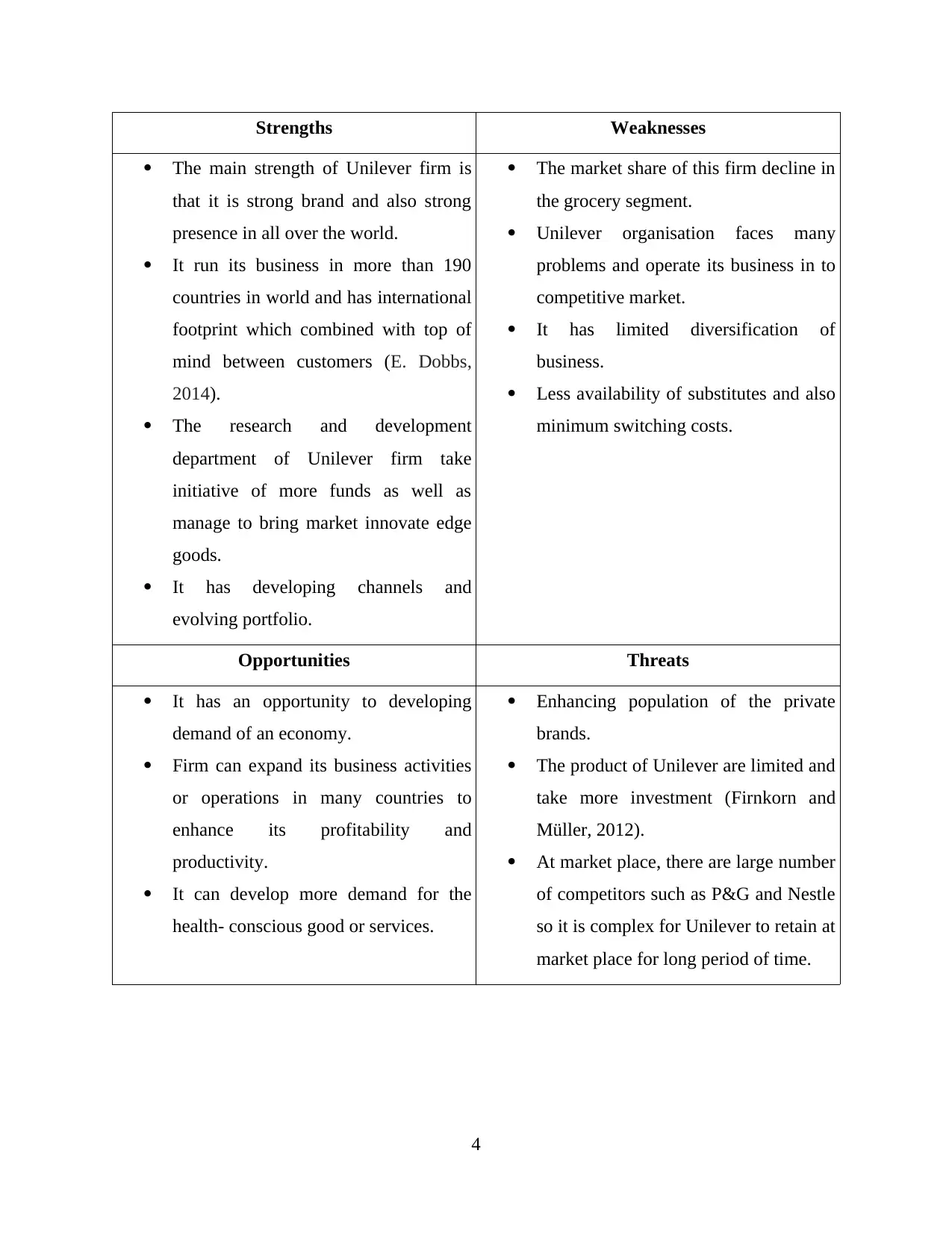
Strengths Weaknesses
The main strength of Unilever firm is
that it is strong brand and also strong
presence in all over the world.
It run its business in more than 190
countries in world and has international
footprint which combined with top of
mind between customers (E. Dobbs,
2014).
The research and development
department of Unilever firm take
initiative of more funds as well as
manage to bring market innovate edge
goods.
It has developing channels and
evolving portfolio.
The market share of this firm decline in
the grocery segment.
Unilever organisation faces many
problems and operate its business in to
competitive market.
It has limited diversification of
business.
Less availability of substitutes and also
minimum switching costs.
Opportunities Threats
It has an opportunity to developing
demand of an economy.
Firm can expand its business activities
or operations in many countries to
enhance its profitability and
productivity.
It can develop more demand for the
health- conscious good or services.
Enhancing population of the private
brands.
The product of Unilever are limited and
take more investment (Firnkorn and
Müller, 2012).
At market place, there are large number
of competitors such as P&G and Nestle
so it is complex for Unilever to retain at
market place for long period of time.
4
The main strength of Unilever firm is
that it is strong brand and also strong
presence in all over the world.
It run its business in more than 190
countries in world and has international
footprint which combined with top of
mind between customers (E. Dobbs,
2014).
The research and development
department of Unilever firm take
initiative of more funds as well as
manage to bring market innovate edge
goods.
It has developing channels and
evolving portfolio.
The market share of this firm decline in
the grocery segment.
Unilever organisation faces many
problems and operate its business in to
competitive market.
It has limited diversification of
business.
Less availability of substitutes and also
minimum switching costs.
Opportunities Threats
It has an opportunity to developing
demand of an economy.
Firm can expand its business activities
or operations in many countries to
enhance its profitability and
productivity.
It can develop more demand for the
health- conscious good or services.
Enhancing population of the private
brands.
The product of Unilever are limited and
take more investment (Firnkorn and
Müller, 2012).
At market place, there are large number
of competitors such as P&G and Nestle
so it is complex for Unilever to retain at
market place for long period of time.
4
⊘ This is a preview!⊘
Do you want full access?
Subscribe today to unlock all pages.

Trusted by 1+ million students worldwide
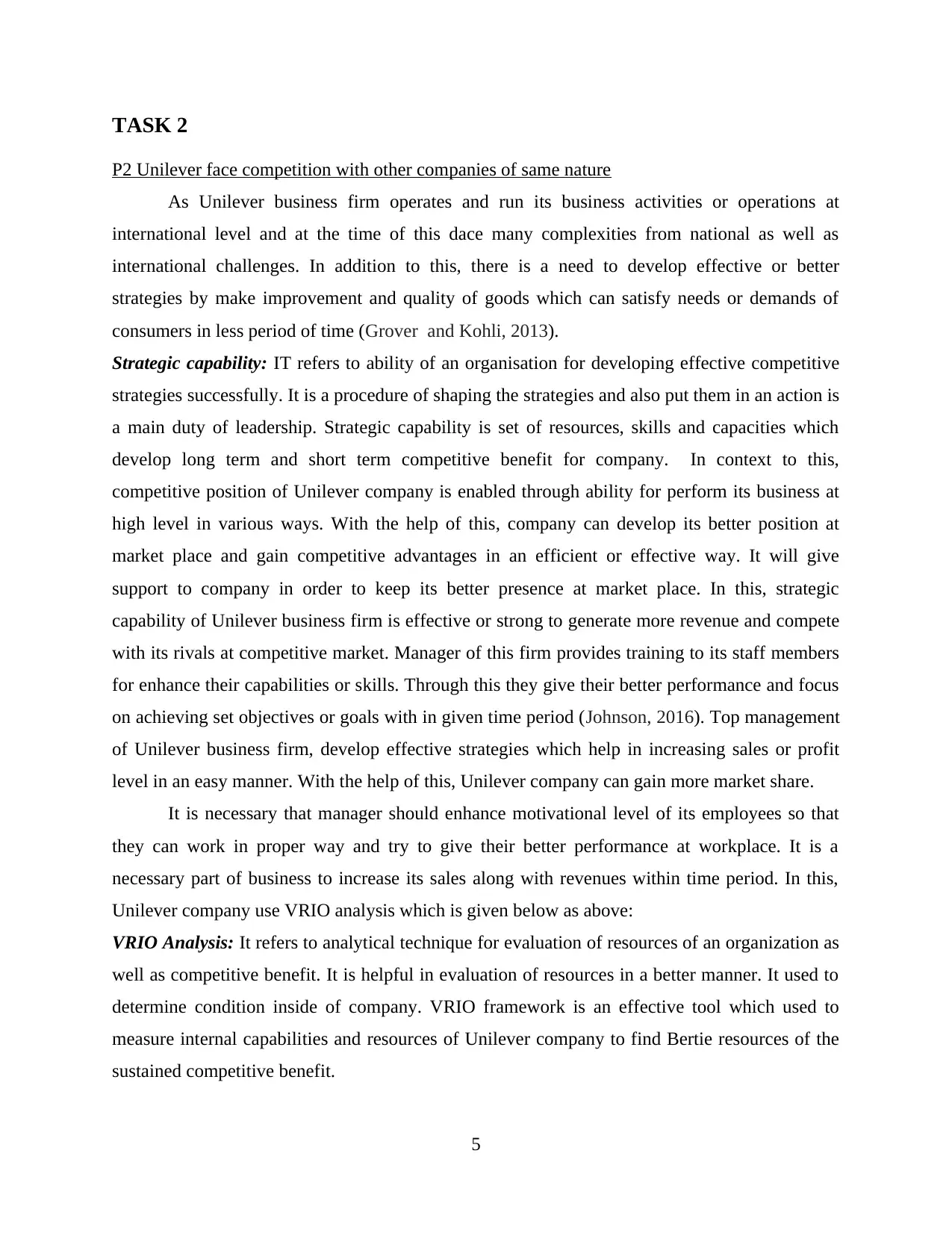
TASK 2
P2 Unilever face competition with other companies of same nature
As Unilever business firm operates and run its business activities or operations at
international level and at the time of this dace many complexities from national as well as
international challenges. In addition to this, there is a need to develop effective or better
strategies by make improvement and quality of goods which can satisfy needs or demands of
consumers in less period of time (Grover and Kohli, 2013).
Strategic capability: IT refers to ability of an organisation for developing effective competitive
strategies successfully. It is a procedure of shaping the strategies and also put them in an action is
a main duty of leadership. Strategic capability is set of resources, skills and capacities which
develop long term and short term competitive benefit for company. In context to this,
competitive position of Unilever company is enabled through ability for perform its business at
high level in various ways. With the help of this, company can develop its better position at
market place and gain competitive advantages in an efficient or effective way. It will give
support to company in order to keep its better presence at market place. In this, strategic
capability of Unilever business firm is effective or strong to generate more revenue and compete
with its rivals at competitive market. Manager of this firm provides training to its staff members
for enhance their capabilities or skills. Through this they give their better performance and focus
on achieving set objectives or goals with in given time period (Johnson, 2016). Top management
of Unilever business firm, develop effective strategies which help in increasing sales or profit
level in an easy manner. With the help of this, Unilever company can gain more market share.
It is necessary that manager should enhance motivational level of its employees so that
they can work in proper way and try to give their better performance at workplace. It is a
necessary part of business to increase its sales along with revenues within time period. In this,
Unilever company use VRIO analysis which is given below as above:
VRIO Analysis: It refers to analytical technique for evaluation of resources of an organization as
well as competitive benefit. It is helpful in evaluation of resources in a better manner. It used to
determine condition inside of company. VRIO framework is an effective tool which used to
measure internal capabilities and resources of Unilever company to find Bertie resources of the
sustained competitive benefit.
5
P2 Unilever face competition with other companies of same nature
As Unilever business firm operates and run its business activities or operations at
international level and at the time of this dace many complexities from national as well as
international challenges. In addition to this, there is a need to develop effective or better
strategies by make improvement and quality of goods which can satisfy needs or demands of
consumers in less period of time (Grover and Kohli, 2013).
Strategic capability: IT refers to ability of an organisation for developing effective competitive
strategies successfully. It is a procedure of shaping the strategies and also put them in an action is
a main duty of leadership. Strategic capability is set of resources, skills and capacities which
develop long term and short term competitive benefit for company. In context to this,
competitive position of Unilever company is enabled through ability for perform its business at
high level in various ways. With the help of this, company can develop its better position at
market place and gain competitive advantages in an efficient or effective way. It will give
support to company in order to keep its better presence at market place. In this, strategic
capability of Unilever business firm is effective or strong to generate more revenue and compete
with its rivals at competitive market. Manager of this firm provides training to its staff members
for enhance their capabilities or skills. Through this they give their better performance and focus
on achieving set objectives or goals with in given time period (Johnson, 2016). Top management
of Unilever business firm, develop effective strategies which help in increasing sales or profit
level in an easy manner. With the help of this, Unilever company can gain more market share.
It is necessary that manager should enhance motivational level of its employees so that
they can work in proper way and try to give their better performance at workplace. It is a
necessary part of business to increase its sales along with revenues within time period. In this,
Unilever company use VRIO analysis which is given below as above:
VRIO Analysis: It refers to analytical technique for evaluation of resources of an organization as
well as competitive benefit. It is helpful in evaluation of resources in a better manner. It used to
determine condition inside of company. VRIO framework is an effective tool which used to
measure internal capabilities and resources of Unilever company to find Bertie resources of the
sustained competitive benefit.
5
Paraphrase This Document
Need a fresh take? Get an instant paraphrase of this document with our AI Paraphraser
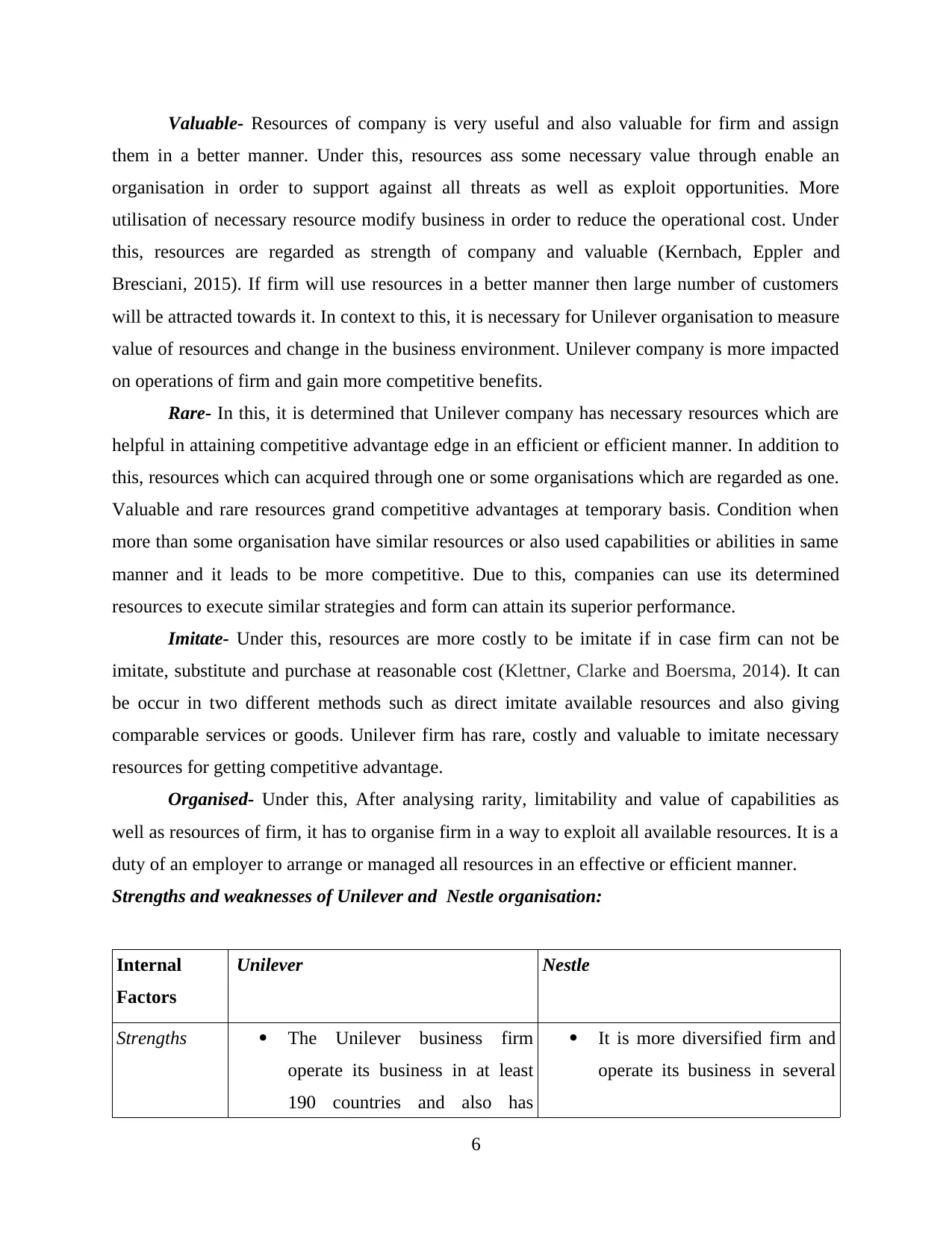
Valuable- Resources of company is very useful and also valuable for firm and assign
them in a better manner. Under this, resources ass some necessary value through enable an
organisation in order to support against all threats as well as exploit opportunities. More
utilisation of necessary resource modify business in order to reduce the operational cost. Under
this, resources are regarded as strength of company and valuable (Kernbach, Eppler and
Bresciani, 2015). If firm will use resources in a better manner then large number of customers
will be attracted towards it. In context to this, it is necessary for Unilever organisation to measure
value of resources and change in the business environment. Unilever company is more impacted
on operations of firm and gain more competitive benefits.
Rare- In this, it is determined that Unilever company has necessary resources which are
helpful in attaining competitive advantage edge in an efficient or efficient manner. In addition to
this, resources which can acquired through one or some organisations which are regarded as one.
Valuable and rare resources grand competitive advantages at temporary basis. Condition when
more than some organisation have similar resources or also used capabilities or abilities in same
manner and it leads to be more competitive. Due to this, companies can use its determined
resources to execute similar strategies and form can attain its superior performance.
Imitate- Under this, resources are more costly to be imitate if in case firm can not be
imitate, substitute and purchase at reasonable cost (Klettner, Clarke and Boersma, 2014). It can
be occur in two different methods such as direct imitate available resources and also giving
comparable services or goods. Unilever firm has rare, costly and valuable to imitate necessary
resources for getting competitive advantage.
Organised- Under this, After analysing rarity, limitability and value of capabilities as
well as resources of firm, it has to organise firm in a way to exploit all available resources. It is a
duty of an employer to arrange or managed all resources in an effective or efficient manner.
Strengths and weaknesses of Unilever and Nestle organisation:
Internal
Factors
Unilever Nestle
Strengths The Unilever business firm
operate its business in at least
190 countries and also has
It is more diversified firm and
operate its business in several
6
them in a better manner. Under this, resources ass some necessary value through enable an
organisation in order to support against all threats as well as exploit opportunities. More
utilisation of necessary resource modify business in order to reduce the operational cost. Under
this, resources are regarded as strength of company and valuable (Kernbach, Eppler and
Bresciani, 2015). If firm will use resources in a better manner then large number of customers
will be attracted towards it. In context to this, it is necessary for Unilever organisation to measure
value of resources and change in the business environment. Unilever company is more impacted
on operations of firm and gain more competitive benefits.
Rare- In this, it is determined that Unilever company has necessary resources which are
helpful in attaining competitive advantage edge in an efficient or efficient manner. In addition to
this, resources which can acquired through one or some organisations which are regarded as one.
Valuable and rare resources grand competitive advantages at temporary basis. Condition when
more than some organisation have similar resources or also used capabilities or abilities in same
manner and it leads to be more competitive. Due to this, companies can use its determined
resources to execute similar strategies and form can attain its superior performance.
Imitate- Under this, resources are more costly to be imitate if in case firm can not be
imitate, substitute and purchase at reasonable cost (Klettner, Clarke and Boersma, 2014). It can
be occur in two different methods such as direct imitate available resources and also giving
comparable services or goods. Unilever firm has rare, costly and valuable to imitate necessary
resources for getting competitive advantage.
Organised- Under this, After analysing rarity, limitability and value of capabilities as
well as resources of firm, it has to organise firm in a way to exploit all available resources. It is a
duty of an employer to arrange or managed all resources in an effective or efficient manner.
Strengths and weaknesses of Unilever and Nestle organisation:
Internal
Factors
Unilever Nestle
Strengths The Unilever business firm
operate its business in at least
190 countries and also has
It is more diversified firm and
operate its business in several
6
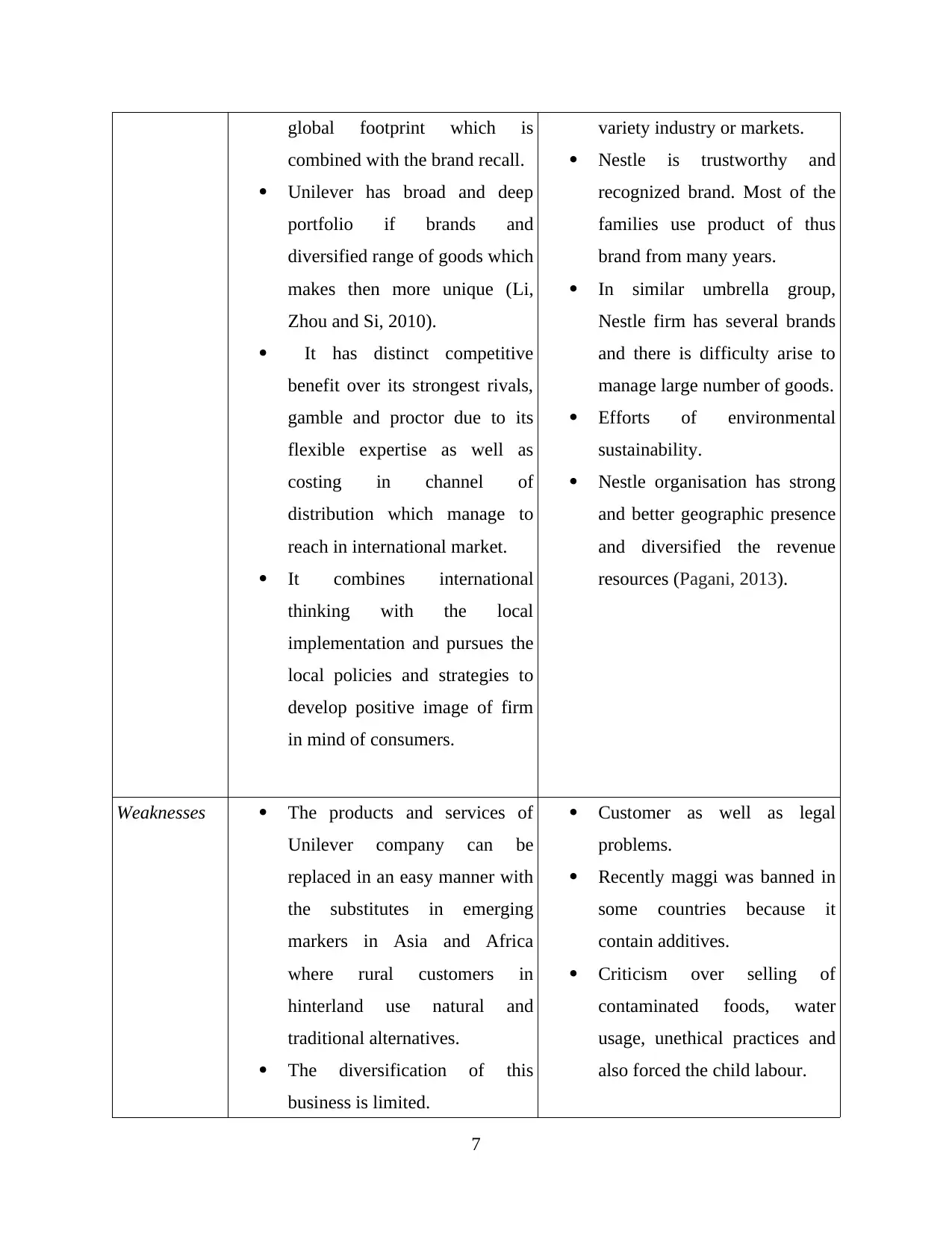
global footprint which is
combined with the brand recall.
Unilever has broad and deep
portfolio if brands and
diversified range of goods which
makes then more unique (Li,
Zhou and Si, 2010).
It has distinct competitive
benefit over its strongest rivals,
gamble and proctor due to its
flexible expertise as well as
costing in channel of
distribution which manage to
reach in international market.
It combines international
thinking with the local
implementation and pursues the
local policies and strategies to
develop positive image of firm
in mind of consumers.
variety industry or markets.
Nestle is trustworthy and
recognized brand. Most of the
families use product of thus
brand from many years.
In similar umbrella group,
Nestle firm has several brands
and there is difficulty arise to
manage large number of goods.
Efforts of environmental
sustainability.
Nestle organisation has strong
and better geographic presence
and diversified the revenue
resources (Pagani, 2013).
Weaknesses The products and services of
Unilever company can be
replaced in an easy manner with
the substitutes in emerging
markers in Asia and Africa
where rural customers in
hinterland use natural and
traditional alternatives.
The diversification of this
business is limited.
Customer as well as legal
problems.
Recently maggi was banned in
some countries because it
contain additives.
Criticism over selling of
contaminated foods, water
usage, unethical practices and
also forced the child labour.
7
combined with the brand recall.
Unilever has broad and deep
portfolio if brands and
diversified range of goods which
makes then more unique (Li,
Zhou and Si, 2010).
It has distinct competitive
benefit over its strongest rivals,
gamble and proctor due to its
flexible expertise as well as
costing in channel of
distribution which manage to
reach in international market.
It combines international
thinking with the local
implementation and pursues the
local policies and strategies to
develop positive image of firm
in mind of consumers.
variety industry or markets.
Nestle is trustworthy and
recognized brand. Most of the
families use product of thus
brand from many years.
In similar umbrella group,
Nestle firm has several brands
and there is difficulty arise to
manage large number of goods.
Efforts of environmental
sustainability.
Nestle organisation has strong
and better geographic presence
and diversified the revenue
resources (Pagani, 2013).
Weaknesses The products and services of
Unilever company can be
replaced in an easy manner with
the substitutes in emerging
markers in Asia and Africa
where rural customers in
hinterland use natural and
traditional alternatives.
The diversification of this
business is limited.
Customer as well as legal
problems.
Recently maggi was banned in
some countries because it
contain additives.
Criticism over selling of
contaminated foods, water
usage, unethical practices and
also forced the child labour.
7
⊘ This is a preview!⊘
Do you want full access?
Subscribe today to unlock all pages.

Trusted by 1+ million students worldwide
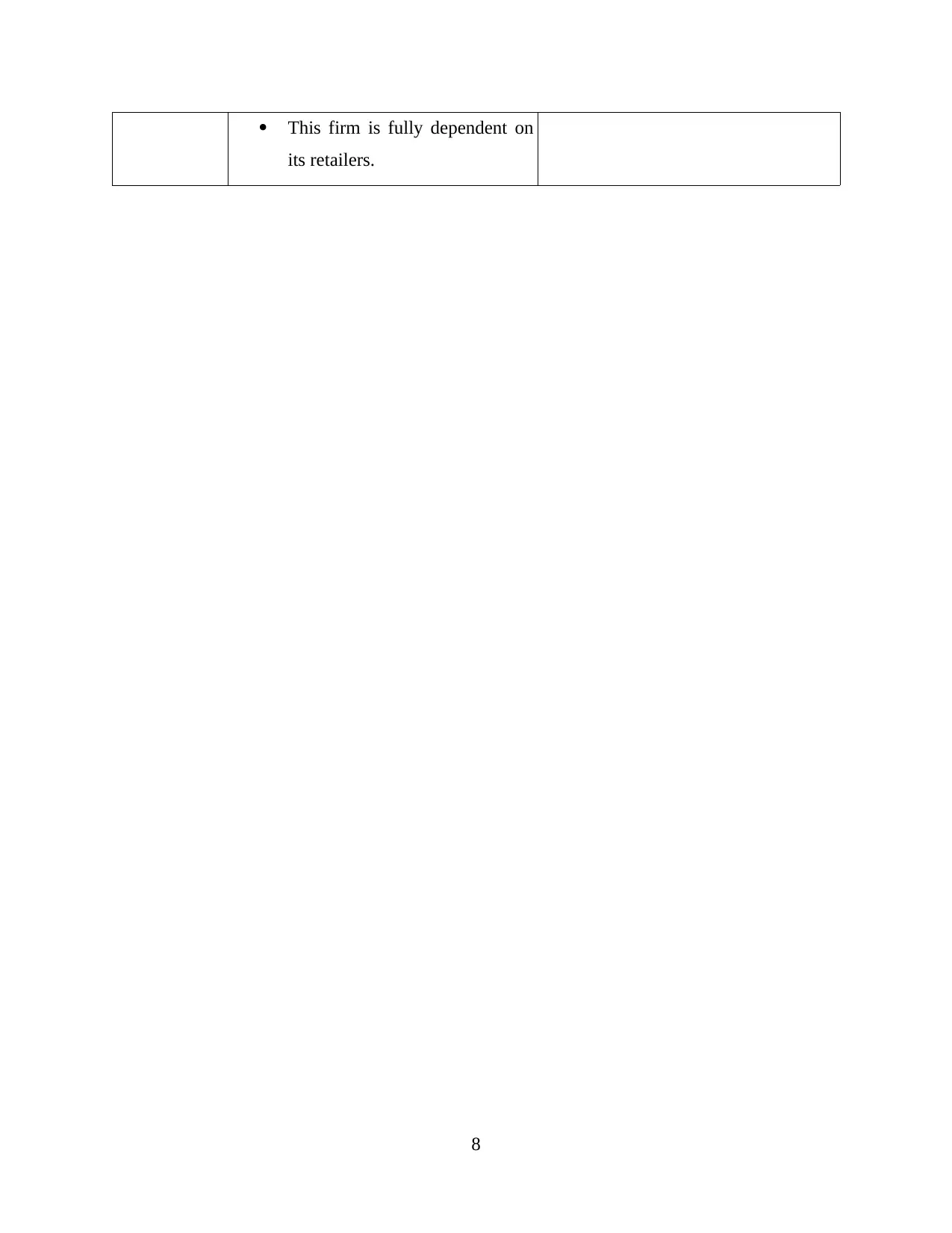
This firm is fully dependent on
its retailers.
8
its retailers.
8
Paraphrase This Document
Need a fresh take? Get an instant paraphrase of this document with our AI Paraphraser
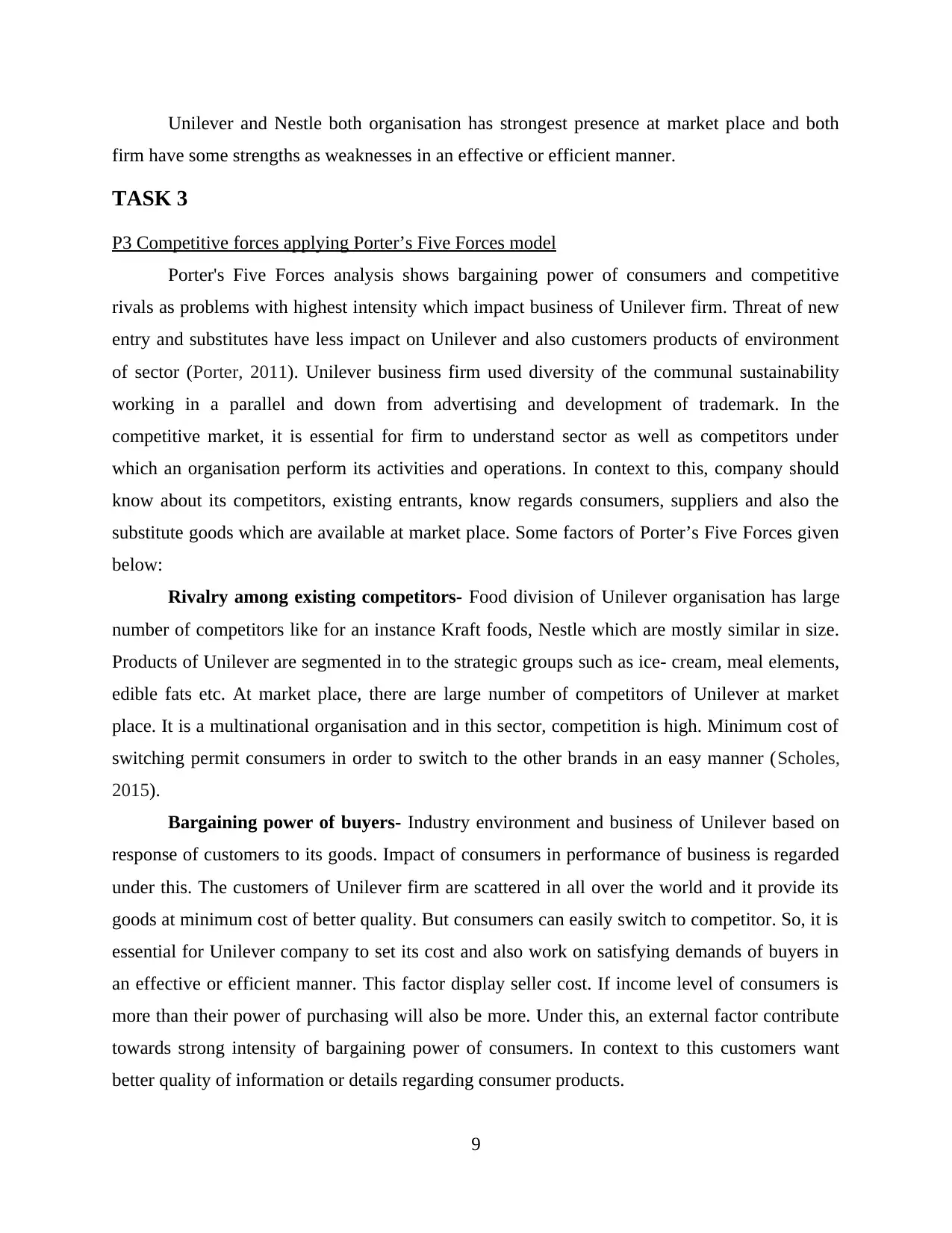
Unilever and Nestle both organisation has strongest presence at market place and both
firm have some strengths as weaknesses in an effective or efficient manner.
TASK 3
P3 Competitive forces applying Porter’s Five Forces model
Porter's Five Forces analysis shows bargaining power of consumers and competitive
rivals as problems with highest intensity which impact business of Unilever firm. Threat of new
entry and substitutes have less impact on Unilever and also customers products of environment
of sector (Porter, 2011). Unilever business firm used diversity of the communal sustainability
working in a parallel and down from advertising and development of trademark. In the
competitive market, it is essential for firm to understand sector as well as competitors under
which an organisation perform its activities and operations. In context to this, company should
know about its competitors, existing entrants, know regards consumers, suppliers and also the
substitute goods which are available at market place. Some factors of Porter’s Five Forces given
below:
Rivalry among existing competitors- Food division of Unilever organisation has large
number of competitors like for an instance Kraft foods, Nestle which are mostly similar in size.
Products of Unilever are segmented in to the strategic groups such as ice- cream, meal elements,
edible fats etc. At market place, there are large number of competitors of Unilever at market
place. It is a multinational organisation and in this sector, competition is high. Minimum cost of
switching permit consumers in order to switch to the other brands in an easy manner (Scholes,
2015).
Bargaining power of buyers- Industry environment and business of Unilever based on
response of customers to its goods. Impact of consumers in performance of business is regarded
under this. The customers of Unilever firm are scattered in all over the world and it provide its
goods at minimum cost of better quality. But consumers can easily switch to competitor. So, it is
essential for Unilever company to set its cost and also work on satisfying demands of buyers in
an effective or efficient manner. This factor display seller cost. If income level of consumers is
more than their power of purchasing will also be more. Under this, an external factor contribute
towards strong intensity of bargaining power of consumers. In context to this customers want
better quality of information or details regarding consumer products.
9
firm have some strengths as weaknesses in an effective or efficient manner.
TASK 3
P3 Competitive forces applying Porter’s Five Forces model
Porter's Five Forces analysis shows bargaining power of consumers and competitive
rivals as problems with highest intensity which impact business of Unilever firm. Threat of new
entry and substitutes have less impact on Unilever and also customers products of environment
of sector (Porter, 2011). Unilever business firm used diversity of the communal sustainability
working in a parallel and down from advertising and development of trademark. In the
competitive market, it is essential for firm to understand sector as well as competitors under
which an organisation perform its activities and operations. In context to this, company should
know about its competitors, existing entrants, know regards consumers, suppliers and also the
substitute goods which are available at market place. Some factors of Porter’s Five Forces given
below:
Rivalry among existing competitors- Food division of Unilever organisation has large
number of competitors like for an instance Kraft foods, Nestle which are mostly similar in size.
Products of Unilever are segmented in to the strategic groups such as ice- cream, meal elements,
edible fats etc. At market place, there are large number of competitors of Unilever at market
place. It is a multinational organisation and in this sector, competition is high. Minimum cost of
switching permit consumers in order to switch to the other brands in an easy manner (Scholes,
2015).
Bargaining power of buyers- Industry environment and business of Unilever based on
response of customers to its goods. Impact of consumers in performance of business is regarded
under this. The customers of Unilever firm are scattered in all over the world and it provide its
goods at minimum cost of better quality. But consumers can easily switch to competitor. So, it is
essential for Unilever company to set its cost and also work on satisfying demands of buyers in
an effective or efficient manner. This factor display seller cost. If income level of consumers is
more than their power of purchasing will also be more. Under this, an external factor contribute
towards strong intensity of bargaining power of consumers. In context to this customers want
better quality of information or details regarding consumer products.
9
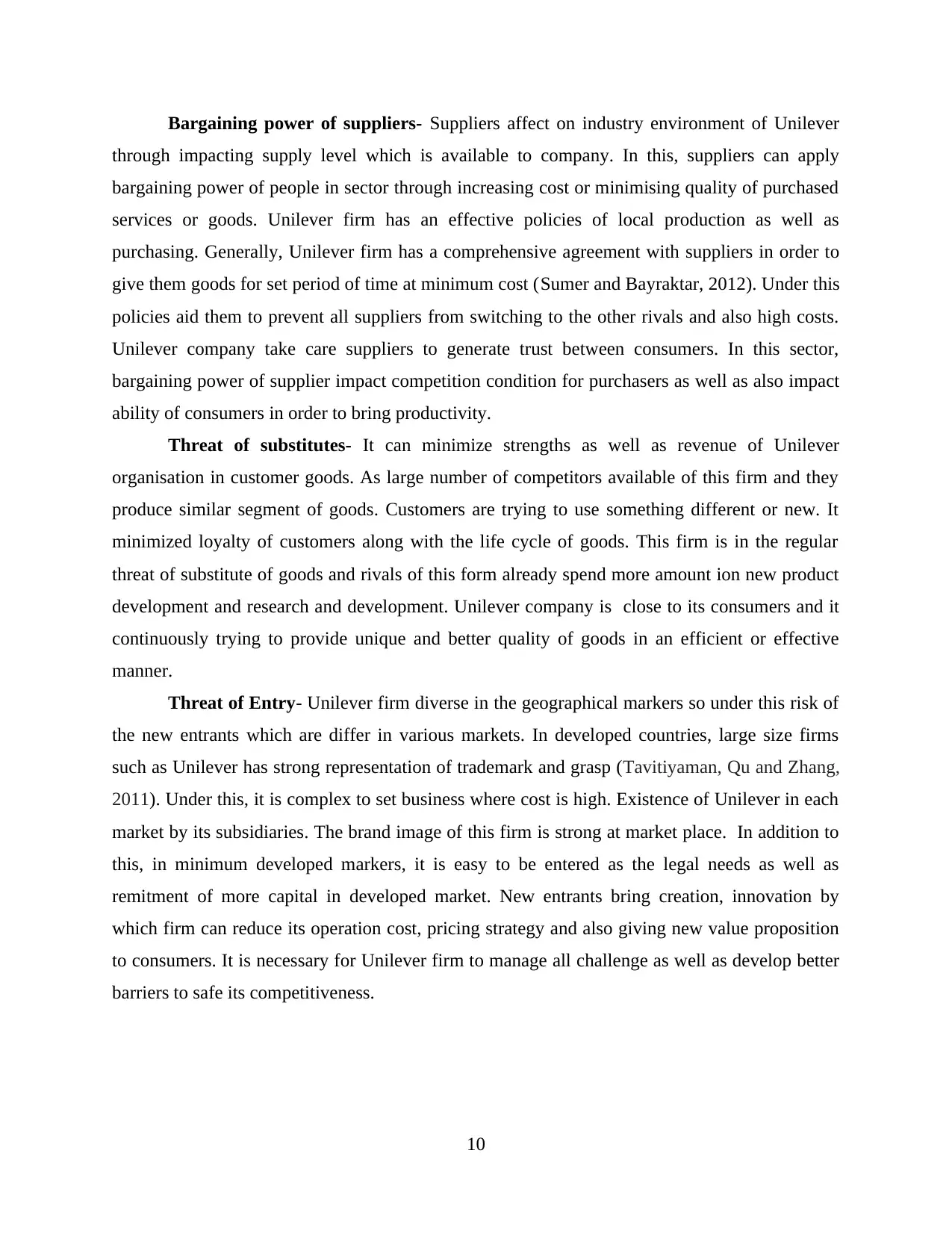
Bargaining power of suppliers- Suppliers affect on industry environment of Unilever
through impacting supply level which is available to company. In this, suppliers can apply
bargaining power of people in sector through increasing cost or minimising quality of purchased
services or goods. Unilever firm has an effective policies of local production as well as
purchasing. Generally, Unilever firm has a comprehensive agreement with suppliers in order to
give them goods for set period of time at minimum cost (Sumer and Bayraktar, 2012). Under this
policies aid them to prevent all suppliers from switching to the other rivals and also high costs.
Unilever company take care suppliers to generate trust between consumers. In this sector,
bargaining power of supplier impact competition condition for purchasers as well as also impact
ability of consumers in order to bring productivity.
Threat of substitutes- It can minimize strengths as well as revenue of Unilever
organisation in customer goods. As large number of competitors available of this firm and they
produce similar segment of goods. Customers are trying to use something different or new. It
minimized loyalty of customers along with the life cycle of goods. This firm is in the regular
threat of substitute of goods and rivals of this form already spend more amount ion new product
development and research and development. Unilever company is close to its consumers and it
continuously trying to provide unique and better quality of goods in an efficient or effective
manner.
Threat of Entry- Unilever firm diverse in the geographical markers so under this risk of
the new entrants which are differ in various markets. In developed countries, large size firms
such as Unilever has strong representation of trademark and grasp (Tavitiyaman, Qu and Zhang,
2011). Under this, it is complex to set business where cost is high. Existence of Unilever in each
market by its subsidiaries. The brand image of this firm is strong at market place. In addition to
this, in minimum developed markers, it is easy to be entered as the legal needs as well as
remitment of more capital in developed market. New entrants bring creation, innovation by
which firm can reduce its operation cost, pricing strategy and also giving new value proposition
to consumers. It is necessary for Unilever firm to manage all challenge as well as develop better
barriers to safe its competitiveness.
10
through impacting supply level which is available to company. In this, suppliers can apply
bargaining power of people in sector through increasing cost or minimising quality of purchased
services or goods. Unilever firm has an effective policies of local production as well as
purchasing. Generally, Unilever firm has a comprehensive agreement with suppliers in order to
give them goods for set period of time at minimum cost (Sumer and Bayraktar, 2012). Under this
policies aid them to prevent all suppliers from switching to the other rivals and also high costs.
Unilever company take care suppliers to generate trust between consumers. In this sector,
bargaining power of supplier impact competition condition for purchasers as well as also impact
ability of consumers in order to bring productivity.
Threat of substitutes- It can minimize strengths as well as revenue of Unilever
organisation in customer goods. As large number of competitors available of this firm and they
produce similar segment of goods. Customers are trying to use something different or new. It
minimized loyalty of customers along with the life cycle of goods. This firm is in the regular
threat of substitute of goods and rivals of this form already spend more amount ion new product
development and research and development. Unilever company is close to its consumers and it
continuously trying to provide unique and better quality of goods in an efficient or effective
manner.
Threat of Entry- Unilever firm diverse in the geographical markers so under this risk of
the new entrants which are differ in various markets. In developed countries, large size firms
such as Unilever has strong representation of trademark and grasp (Tavitiyaman, Qu and Zhang,
2011). Under this, it is complex to set business where cost is high. Existence of Unilever in each
market by its subsidiaries. The brand image of this firm is strong at market place. In addition to
this, in minimum developed markers, it is easy to be entered as the legal needs as well as
remitment of more capital in developed market. New entrants bring creation, innovation by
which firm can reduce its operation cost, pricing strategy and also giving new value proposition
to consumers. It is necessary for Unilever firm to manage all challenge as well as develop better
barriers to safe its competitiveness.
10
⊘ This is a preview!⊘
Do you want full access?
Subscribe today to unlock all pages.

Trusted by 1+ million students worldwide
1 out of 15
Related Documents
Your All-in-One AI-Powered Toolkit for Academic Success.
+13062052269
info@desklib.com
Available 24*7 on WhatsApp / Email
![[object Object]](/_next/static/media/star-bottom.7253800d.svg)
Unlock your academic potential
Copyright © 2020–2025 A2Z Services. All Rights Reserved. Developed and managed by ZUCOL.





